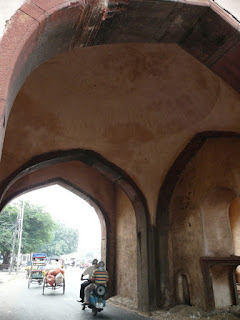 |
| northern gate way tripolia, delhi. en.wikipedia. org. |
 |
| North side Tripolia Gateway, gate way. flicker.com |
 |
| inside the Tripola gateway. Delhi. gocityguides.com |
 |
| unrestored tripolia gateway,Delhi in the past. pressreader.com |
 |
| Mogul ruler Muhammad Shah (1702-1748) en.wikipedia org |
layers, the two facing gateways have three arched openings and
flat domes and lime- plaster finish. The gates were often used
by Moguls and when they feared an attack, the gateways’ massive doors were pulled down. and lime- plaster finish. The walls
of the gateways are built 1.5 m into the raised ground level.
The purpose is the connecting passages between the roadways
that have waist-high sandstone barriers could be used to pass underneath them. The gate must have had better plaster coating
that could withstand the ravages of time. In some gate ways
there are jharokha (overhanging enclosed balconies) in the main structure openings on either end at the upper level. The red sand stones with which they are made of, give an impressive look.
The restoration is going on in the other gate. It is a belated response.
In one of the gates, the fine calligraphy in the lower level and the stonework either became too faded or crumpled almost beyond resumption. The calligraphy at the upper reaches of the arches and the inscriptions there, etc have survived the time. The other gate needs urgent repair. In the past the gateway sank a foot or two below ground level due to heavy motor vehicle traffic. Further, the road level also increased every time when laying a fresh coat of asphalt. The roof was damp because of seepage of water during rainy time. This further complicated by moisture problem.
ooo
Tripolia gateway, Narnaul, Haryana:
 |
| Tripolia gateway, Narnaul, Haryana. haryanatourism.gov.in/ |
Shah-Quil Khan, apart from being a great warrior he was close to Emperor Akbar. He was a noble in his court and held the post of the Governor of Punjab. He got the post in 1575 AD and died in Agra in 1601 AD. Narnaul, being his favorite place Shah Quil had spent much part of his life here. Keenly interested in erecting buildings, he focused his attention on a nice garden in that time and named it as Aram-i-Kausar. His yet another contribution is the Tripolia Gateway, the main entrance to the beautiful garden. Within the precincts of the garden compound, the gateway is an elegant three-story structure made with rubble masonry and thick layer of lime plaster. The interior walls and ceilings of the façade have beautiful ornamental carvings done with particular care. The inscriptions on the pointed arch of the entrance gate mention the name of the garden, its builder and the date of its construction.
.jfif)



.jfif)




